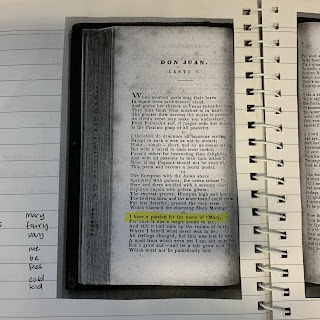Conferences, Navarre and 'gutterance'
Dear Void,
This post is just to log in and say 'hello, I'm still here. And this is what I've been doing and thinking about.'
Last week was a run-around week. It took me some days to get my bits and pieces in order. Most importantly I had to find my passport (which expired nearly 20 years ago, so not an easy task) and make moves to update it because, Void, I’m heading over to Coventry at the end of May to present at the conference Anonymity, Un-Originality, Collectivity – Contested Modes of Authorship hosted by the University of Warwick.
* * * *
Last weekend I read Novels, Tales and Stories, Margaret de Valois, of Navarre an abridged eighteenth century English translation from the French. I’d printed out the 'original' and read as if reading as perhaps Lady Mary Wortley Montagu had. Or did she have a hand in translating the work from the French in 1725? Did Mary Astell too? These were my unbidden daydreams. [Remember I’m not doing proper history here; I’m letting you in on the thought processes around my practice as a poet-scholar].
Margaret of Navarre, the C16th writer/Queen, doesn’t feature anywhere in the 1837/1898 edition of Lady Mary’s Letters I & II. But Lady’s Mary biographer Robert Halsband refers to an epistolary essay* in which she had ‘pretended to be answering a letter received from Margaret of Navarre.’ The essay can be found online here for those interested and if you have access to Oxford Scholarly Editions Online (try through your university library). Warning: you may fall in love with Lady Mary and find yourself compelled to declare as Byron did in his Canto V of Don Juan: ‘’I have a passion for the name of “Mary.” More about Byron’s fanboy-dom later.
Robert Halsband’s high regard and affection for Lady Mary is clear by the end of his biography: ‘The extraordinary woman had gone beyond the boundaries of her time and class’ (Halsband: 292).
* Wortley MS viii; excerpts in Halsband, The Life of Lady Mary Wortley Montagu, p. 232
 |
| Notebook April 2021: Mary, fairy, vary, me, be, free, cold, told. |
* * * *
Last week when I was referring to Marjorie Perloff’s essay on Susan Howe as ‘Statistical Traffic,’ I forgot about the rattle. The full title is ‘The Rattle of Statistical Traffic.’ I was omitting the crucial element of sound that is created as elements pass one another, that quantum whoosh, or the sound of the distance or proximity of things, perhaps in juxtaposition if only for a moment, random fluctuating signals, the buzz across the spark gap.
And rattle its other sense too, to unnerve, to fluster. Perhaps, unsettle? The word ‘rattle’ brings sense back to the body. If text is a speech act (and let’s say it is) then those moments where Howe tries to articulate and sound out those little whisps of text that can be seen once those four Yeats titles (faded, in pencil) are thrown onto each other (Susan Howe, The Midnight, 2013: 76) are sound particulars.
This is utterance is its pure form. Would you allow me a new word: ‘gutterance’? Remember the little stick figure running into the gutter in the image on page 59 of The Midnight? I talk about it here.
All that is left to be uttered are letters relaying their phonemes, still functioning signs for sounds, there to be guh-uttered. Cold letters, cold sounds. Trying to warm:
‘Oh-nn’
‘Trrrrehst’
‘Heee’
‘An
“Oh’
‘Tuh mmmm’
‘Sssss’
‘Huh’
Jx
Halsband, Robert. The Life of Lady Mary Wortley Montagu. New York: Oxford University Press, 1960.
Howe, Susan. The Midnight. New York: New Directions Books, 2003.
Perloff, Marjorie. “‘The Rattle of Statistical Traffic’: Citation and Found Text in Susan Howe’s The Midnight.” Boundary 2 36, no. 3 (2009): 205–228.
Soundtrack, as usual, has been Glenn Gould plays The Goldberg Variations


Comments
Post a Comment